Category: Archives
A Promising Cancer Treatment Made Patients Worse, Not Better
Denise Grady in The New York Times:
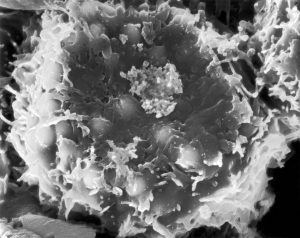 Drugs that activate the immune system to fight cancer have brought remarkable recoveries to many people in recent years. But one of those drugs seems to have had the opposite effect on three patients with an uncommon blood cancer who were taking part in a study. After a single treatment, their disease quickly became much worse, doctors reported in a letter to The New England Journal of Medicine. The cases are a sobering reminder that immunotherapy is still in its early days, and can unleash powerful forces that are not fully understood. Patients and doctors are eager to try the treatments when other options have run out, even for cancers in which they haven’t yet been tested. Sometimes those hail-Mary efforts work. But they can backfire. The patients, treated last year at different hospitals, had adult T-cell leukemia-lymphoma, which is caused by a virus. The drug was nivolumab, or Opdivo, which belongs to a class called checkpoint inhibitors. The drugs cost more than $100,000 a year. Nivolumab, made by Bristol-Myers Squibb, has been approved to treat eight types of cancer, but not this type of lymphoma.
Drugs that activate the immune system to fight cancer have brought remarkable recoveries to many people in recent years. But one of those drugs seems to have had the opposite effect on three patients with an uncommon blood cancer who were taking part in a study. After a single treatment, their disease quickly became much worse, doctors reported in a letter to The New England Journal of Medicine. The cases are a sobering reminder that immunotherapy is still in its early days, and can unleash powerful forces that are not fully understood. Patients and doctors are eager to try the treatments when other options have run out, even for cancers in which they haven’t yet been tested. Sometimes those hail-Mary efforts work. But they can backfire. The patients, treated last year at different hospitals, had adult T-cell leukemia-lymphoma, which is caused by a virus. The drug was nivolumab, or Opdivo, which belongs to a class called checkpoint inhibitors. The drugs cost more than $100,000 a year. Nivolumab, made by Bristol-Myers Squibb, has been approved to treat eight types of cancer, but not this type of lymphoma.
…The patients described in the journal were the first three in a nationwide clinical trial meant to test the drug in 20 people with the lymphoma. But after the third got worse instead of better, researchers shut down the study, which was funded by the National Cancer Institute. They wrote to the journal to alert other doctors to the potential risk of giving the drug, a form of immunotherapy, to patients with that type of lymphoma.
More here.
Mary McCarthy’s Unsparing Honesty
Maggie Doherty at The Nation:
 McCarthy’s fiction, collected by the Library of America in two new volumes, shows how her preoccupation with factuality shaped her art. The collection includes all seven of her novels—the first published in 1942, the last in 1979—as well as collected and uncollected stories and an essay on “the novels that got away.” Through it all, we see McCarthy’s fixation on the surface details that distinguish class and character: a middle-aged man from the Midwest who is given to wearing Brooks Brothers suits; a Yale man working at a leftist magazine who sports a “well-cut brown suit that needed pressing”; bohemian couples living on Cape Cod who drink too much and don’t bother keeping house. We learn that it was a status symbol in 1930s New York for a Vassar graduate to serve coffee with real cream.
McCarthy’s fiction, collected by the Library of America in two new volumes, shows how her preoccupation with factuality shaped her art. The collection includes all seven of her novels—the first published in 1942, the last in 1979—as well as collected and uncollected stories and an essay on “the novels that got away.” Through it all, we see McCarthy’s fixation on the surface details that distinguish class and character: a middle-aged man from the Midwest who is given to wearing Brooks Brothers suits; a Yale man working at a leftist magazine who sports a “well-cut brown suit that needed pressing”; bohemian couples living on Cape Cod who drink too much and don’t bother keeping house. We learn that it was a status symbol in 1930s New York for a Vassar graduate to serve coffee with real cream.
more here.
Ode to Gray
Meghan Flaherty at The Paris Review:

As the black-and-white photographer Henri Cartier-Bresson once said to the color photographer William Eggleston: “You know, William, color is bullshit.” In the realism of the black-and-white, gray is every color—without the tartness. The understudies take the stage, and not one seems to miss the headliners. We see the world without distraction. Andre Gide called gray the color of the truth.
Look at enough black-and-white photography and color comes to feel like an intrusion. Eggleston’s photos seem too vital to be real, as though depicting an alternate reality. Each image is delirious with hue, spectacular, delicious, but a little bit too much. The eye craves rest—and mystery, the kind of truth that can be searched only in subtlety. Dorothy may tumble, tornadic, into Technicolor, but still she always wishes to go home.
more here.
Lives of the Suffragettes
Susan Pedersen at the LRB:
 The wars and revolutions that took place a century ago were so vastly consequential for peoples and nations that historians have had to deal with centenaries queued up like planes coming into Heathrow: 1914, the Easter Rising, the Battle of the Somme, the Balfour Declaration, the Bolshevik Revolution, not to mention the Armistice, the Treaty of Versailles and the Spanish flu epidemic still circling overhead. Museum exhibitions, conferences and popular histories have exposed a more or less interested public to the slaughter-bench that birthed the 20th century.
The wars and revolutions that took place a century ago were so vastly consequential for peoples and nations that historians have had to deal with centenaries queued up like planes coming into Heathrow: 1914, the Easter Rising, the Battle of the Somme, the Balfour Declaration, the Bolshevik Revolution, not to mention the Armistice, the Treaty of Versailles and the Spanish flu epidemic still circling overhead. Museum exhibitions, conferences and popular histories have exposed a more or less interested public to the slaughter-bench that birthed the 20th century.
Amid this catalogue of gore and suffering, one centenary lends itself to celebration. It’s true that the 1918 Representation of the People Act, through which some women in the UK gained the parliamentary vote, is a pretty ambiguous feminist landmark. Introduced to amend residency requirements so that soldiers could vote, the Act was the work of an all-male cross-party conference of 32 MPs that turned to women’s suffrage only in the last stages of its deliberations. With straw polls showing a strong majority favouring some concession to women but a narrow majority opposed to full equality, the conference cast about for grounds on which to include some women and exclude others.
more here.
Thursday Poem
Achilles in Jasper, Texas
I know this: a man walked home drunk
along the corduroy of pines
in east Texas, the bronze duff and
the dust and the late light that fell
on him. Three men gave him a lift
that afternoon and raised him
with their fists and lowered
him with their nigger this and
nigger that and after a while,
when all the fun they could have
with him leaked out into
the ruts of a logging cut,
they tied him to the boat
hitch of their truck and pulled
away. I know he kept his head up
awhile because his elbows were
ground to the bone; I know enough
was finally enough, and his head
left his body behind,
but I don’t know what to do
with this, America, this rage
like Achilles twitching
Hector behind his chariot
for 12 days until even
the gods were ashamed.
by Jeffrey Thomson
from: Split This Rock 2008
Wednesday, August 22, 2018
The Painful Sum of Things
 Pankaj Mishra and Nikil Saval discuss V.S. Naipaul in n+1:
Pankaj Mishra and Nikil Saval discuss V.S. Naipaul in n+1:
Dear Nikil,
You are right: Naipaul did not seek this role of the uniquely positioned reporter on the third world. He found himself in it, and much of his own complicated and tormented relationship with his subjects was bleached out, especially in his writings on Muslim countries. This has at least partly to do with the Anglo-American (and very non-Continental) cult of the no-bullshit, empiricist intellectual—the man who exposes himself to unpleasant or dangerous reality and tells the truth about it, using the clearest of prose. Orwell was the first great figure in this pantheon of cold-war liberalism, and what Raymond Williams said about him in Culture and Society could also be applied to Naipaul.
It is worth quoting Williams on Orwell at length:
He is genuinely baffling until one finds the key to the paradox, which I will call the paradox of the exile. For Orwell was one of a significant number of men who, deprived of a settled way of living, or of a faith, or having rejected those which were inherited, find virtue in a kind of improvised living, and in an assertion of independence. The tradition, in England, is distinguished. It attracts to itself many of the liberal virtues: empiricism, a certain integrity, frankness. It has also, as the normally contingent virtue of exile, certain qualities of perception: in particular, the ability to distinguish inadequacies in the groups which have been rejected. It gives, also, an appearance of strength, although this is largely illusory. The qualities, though salutary, are largely negative; there is an appearance of hardness (the austere criticism of hypocrisy, complacency, self-deceit), but this is usually brittle, and at times hysterical: the substance of community is lacking, and the tension, in men of high quality, is very great.
Williams then goes on to define Orwell as a vagrant, and tries to understand the nature of his appeal, and this applies to Naipaul as well:
Orwell, in different parts of his career, is both exile and vagrant. The vagrant, in literary terms, is the “reporter,” and, where the reporter is good, his work has the merits of novelty and a certain specialized kind of immediacy. The reporter is an observer, an intermediary: it is unlikely that he will understand, in any depth, the life about which he is writing (the vagrant from his own society, or his own class, looking at another, and still inevitably from the outside). But a restless society very easily accepts this kind of achievement.
More here.
UK financial power after Brexit: understanding the country’s external balance sheets
Mona Ali in British Politics and Policy:
 Few nations have been as obsessed with their status in the world as Great Britain. Not surprisingly, the Government Statement at Chequers begins with the words that with its departure from the EU, the UK will ‘begin to chart a new course in the world.’ But can it? In recent research, I assess Britain’s macroeconomic resilience and economic power by examining its external balance sheets. As sovereign power only exists relative to that of other countries, I examine the UK’s balance of payments (BoP) against those of the US.
Few nations have been as obsessed with their status in the world as Great Britain. Not surprisingly, the Government Statement at Chequers begins with the words that with its departure from the EU, the UK will ‘begin to chart a new course in the world.’ But can it? In recent research, I assess Britain’s macroeconomic resilience and economic power by examining its external balance sheets. As sovereign power only exists relative to that of other countries, I examine the UK’s balance of payments (BoP) against those of the US.
The flexibility of a nation’s external balance sheets is an outcome of its monetary power. Powerful currencies enable softer budget constraints. The US, issuer of the world’s predominant currency, finances its deficits by selling dollar-denominated securities to the rest of the world, and so bypasses the onerous process of deficit-reduction—which may involve devaluation, spending cutbacks, and trade protectionism. But BoP flexibility is not just a matter of monetary power. It could also be the outcome of a sovereign state’s standing in the global régime.
More here.
385 Feet of Crazy: The Most Audacious Flying Machine Ever

Steven Levy in Wired:
ON DECEMBER 13, 2011, Paul Allen, the reclusive billionaire and cofounder of Microsoft, stood in front of a group of reporters in Seattle and told them about his wild new plan.
WEARING THE TECH-BRAHMIN uniform of navy blazer, dress shirt, and conspicuously absent tie, Allen made some introductory remarks and then rolled a video simulation of a strange beast of an aircraft leaving an oversize hangar. This was Stratolaunch. It would be the largest airplane, by wingspan, ever created. The twin-fuselage, catamaran-style aircraft would be a flying launchpad, its purpose to heave a half-million-pound rocket ship to cruising altitude and then drop it, whereupon the rocket would ignite its engines for a fiery ascent into space. Allen’s hope was that this extraordinary bird would be able to do quick laps between the ground and the stratosphere, making access to space no more exotic than a New York–to–Boston commuter flight.
Burt Rutan took the microphone next. Rutan, a gregarious designer of exotic aircraft, wore a light-blue work shirt and sported huge Elvis-style muttonchops. He was the original architect of the outlandish endeavor and the person who had sold Allen on the project.
More here.
All the President’s Crooks
The Editorial Board of the New York Times:
 From the start of the Russia investigation, President Trump has been working to discredit the work and the integrity of the special counsel, Robert Mueller; praising men who are blatant grifters, cons and crooks; insisting that he’s personally done nothing wrong; and reminding us that he hires only the best people.
From the start of the Russia investigation, President Trump has been working to discredit the work and the integrity of the special counsel, Robert Mueller; praising men who are blatant grifters, cons and crooks; insisting that he’s personally done nothing wrong; and reminding us that he hires only the best people.
On Tuesday afternoon, the American public was treated to an astonishingsplit-screen moment involving two of those people, as Mr. Trump’s former campaign chief was convicted by a federal jury in Virginia of multiple crimes carrying years in prison at the same time that his longtime personal lawyer pleaded guilty in federal court in New York to his own lengthy trail of criminality, and confessed that he had committed at least some of the crimes “at the direction of” Mr. Trump himself.
Let that sink in: Mr. Trump’s own lawyer has now accused him, under oath, of committing a felony.
More here.
The Riemann Hypothesis
Sean Carroll speaks to Carlo Rovelli about Quantum Mechanics, Spacetime, and Reality
Sean Carroll’s Mindscape podcast at Preposterous Universe:
 Quantum mechanics and general relativity are the two great triumphs of twentieth-century theoretical physics. Unfortunately, they don’t play well together — despite years of effort, we currently lack a completely successful quantum theory of gravity, although there are some promising ideas out there. Carlo Rovelli is a pioneer of one of those ideas, loop quantum gravity, as well as the bestselling author of such books as Seven Brief Lessons on Physics and the recent The Order of Time. We talk about how to make progress on this knotty problem, including whether string theory will play a role (Carlo thinks not).
Quantum mechanics and general relativity are the two great triumphs of twentieth-century theoretical physics. Unfortunately, they don’t play well together — despite years of effort, we currently lack a completely successful quantum theory of gravity, although there are some promising ideas out there. Carlo Rovelli is a pioneer of one of those ideas, loop quantum gravity, as well as the bestselling author of such books as Seven Brief Lessons on Physics and the recent The Order of Time. We talk about how to make progress on this knotty problem, including whether string theory will play a role (Carlo thinks not).
More here.
Is Arsenic a Key Ingredient in the Battle Against Cancer?
Oset Babur in Harvard Magazine:
 Arsenic, the weapon of choice for villains in Agatha Christie’s famed mystery novels, turns out to be a key ingredient in a novel way to combat acute promyelocytic leukemia (APL), a type of cancer that was, until recently, highly lethal.
Arsenic, the weapon of choice for villains in Agatha Christie’s famed mystery novels, turns out to be a key ingredient in a novel way to combat acute promyelocytic leukemia (APL), a type of cancer that was, until recently, highly lethal.
Researchers Kun Ping Lu and Xiao Zhen Zhou of Harvard Medical School and Beth Israel Deaconess Medical Center discovered that oxidized arsenic, commonly known as arsenic trioxide, can effectively target a master cancer regulator protein called Pin1 when paired with all-trans retinoic acid. The research appears in Nature Communication, published on August 9th. Pin1 is an enzyme that the researchers identified more than 20 years ago, and is highly expressed in 60 to 70 percent of common cancers, in which it promotes cancer-cell growth while simultaneously shutting down cells’ natural tumor-suppressor mechanisms. Lu and Zhou found that the combination of arsenic and retinoic acid (a metabolite of Vitamin A) works by successfully inhibiting cancer-driving pathways. The combination is also effective in battling breast cancer that is not susceptible to hormone therapy (triple negative breast cancer, so-called because its growth is not supported by the hormones estrogen or progesterone, nor by the presence of too many HER2 receptors).
More here.
The battle for the soul of biodiversity
Ehsan Masood in Nature:
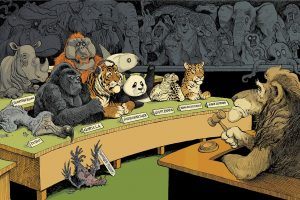 It’s a hot and humid afternoon in the suburbs of Washington DC, and Bob Watson is looking worried. The renowned atmospheric chemist sits back on a bench in his yard, hemmed in by piles of paperwork. He speaks with his characteristic rapid-fire delivery as he explains the tensions surrounding the international committee he helms. The panel is supposed to provide scientific advice on one of the world’s most intractable problems — the rapidly accelerating loss of plants and animals. But a rift in the research community risks diminishing the whole effort. In a few days’ time, Watson will fly to England to mark his seventieth birthday, but right now he is not in a celebratory mood.
It’s a hot and humid afternoon in the suburbs of Washington DC, and Bob Watson is looking worried. The renowned atmospheric chemist sits back on a bench in his yard, hemmed in by piles of paperwork. He speaks with his characteristic rapid-fire delivery as he explains the tensions surrounding the international committee he helms. The panel is supposed to provide scientific advice on one of the world’s most intractable problems — the rapidly accelerating loss of plants and animals. But a rift in the research community risks diminishing the whole effort. In a few days’ time, Watson will fly to England to mark his seventieth birthday, but right now he is not in a celebratory mood.
Watson is talking about a conflict infecting the Intergovernmental Science-Policy Platform on Biodiversity and Ecosystem Services (IPBES), a younger sibling to the Nobel-prizewinning Intergovernmental Panel on Climate Change (IPCC). Both have immense tasks. The IPCC provides timely, expert information on climate change, and it helped to lay the groundwork for international treaties aimed at slowing global warming, such as the 2015 Paris climate accord. The biodiversity panel has been tasked to focus on the epic disappearance of plant and animal populations. As with climate change, humans are the main culprit in biodiversity loss. People have converted somewhere in the region of 50% of Earth’s surface for human activities, and researchers warn that the resulting loss of animal and plant species is leading towards a mass extinction.
More here.
Tuesday, August 21, 2018
California Burning
William Finnegan in the New York Review of Books:
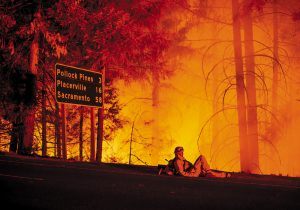 On the northwestern edge of Los Angeles, where I grew up, the wildfires came in late summer. We lived in a new subdivision, and behind our house were the hills, golden and parched. We would hose down the wood-shingled roof as fire crews bivouacked in our street. Our neighborhood never burned, but others did. In the Bel Air fire of 1961, nearly five hundred homes burned, including those of Burt Lancaster and Zsa Zsa Gabor. We were all living in the “wildland-urban interface,” as it is now called. More subdivisions were built, farther out, and for my family the wildfire threat receded.
On the northwestern edge of Los Angeles, where I grew up, the wildfires came in late summer. We lived in a new subdivision, and behind our house were the hills, golden and parched. We would hose down the wood-shingled roof as fire crews bivouacked in our street. Our neighborhood never burned, but others did. In the Bel Air fire of 1961, nearly five hundred homes burned, including those of Burt Lancaster and Zsa Zsa Gabor. We were all living in the “wildland-urban interface,” as it is now called. More subdivisions were built, farther out, and for my family the wildfire threat receded.
Tens of millions of Americans live in that fire-prone interface today—the number keeps growing—and the wildfire threat has become, for a number of political and environmental reasons, immensely more serious. In LA, fire season now stretches into December, as grimly demonstrated by the wildfires that burned across Southern California in late 2017, including the Thomas Fire, in Santa Barbara County, the largest in the state’s modern history. Nationally, fire seasons are on average seventy-eight days longer than they were in 1970, according to the US Forest Service. Wildfires burn twice as many acres as they did thirty years ago. “Of the ten years with the largest amount of acreage burned in the United States,” Edward Struzik notes in Firestorm: How Wildfire Will Shape Our Future, nine have occurred since 2000. Individual fires, meanwhile, are bigger, hotter, faster, more expensive and difficult to fight, and more destructive than ever before. We have entered the era of the megafire—defined as a wildfire that burns more than 100,000 acres.
More here.
‘It made me question my ancestry’: does DNA home testing really understand race?
Georgina Lawton and Daisy Ifama in The Guardian:
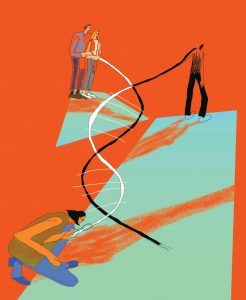 Last year, I did what 12 million people from all over the world have done and surrendered my spit to a home DNA-testing company. I hoped a MyHeritage test would bring me the peace I needed; my Irish mother had never been able to give me any information about my biological father. Raised by her and my white dad, I’d always longed for a country to attribute my blackness to, or for help answering the ubiquitous “Where are you from?” question. I’d spent years making up exotic-sounding combinations to justify my appearance (some days Jamaican-Spanish-Swedish; other days half Brazilian, or half Iranian). But, at 24, I was done with occupying a box of black ambiguity. Could I finally get a clear answer?
Last year, I did what 12 million people from all over the world have done and surrendered my spit to a home DNA-testing company. I hoped a MyHeritage test would bring me the peace I needed; my Irish mother had never been able to give me any information about my biological father. Raised by her and my white dad, I’d always longed for a country to attribute my blackness to, or for help answering the ubiquitous “Where are you from?” question. I’d spent years making up exotic-sounding combinations to justify my appearance (some days Jamaican-Spanish-Swedish; other days half Brazilian, or half Iranian). But, at 24, I was done with occupying a box of black ambiguity. Could I finally get a clear answer?
The results arrived by email on a summer’s day last year. I clicked on the “ethnicity estimate” link, which offers an analysis of DNA by country, my heart pounding as I scanned the digital map.
The test showed that my blackness comes from Nigeria; 43% of my DNA, in fact. Then there’s 1% from Kenya, and the rest from Great Britain and Ireland (55%), as well as eastern Europe (1%). I’d often been told I looked east African, or mixed with multiple countries, so I was surprised by what was nearly a 50:50 split.
I had no cultural knowledge of Nigeria; should I now start claiming it as my own? Did the results mean my very distant ancestors were Nigerian, or that my biological father was probably from there? Why did my features not resemble a typical west African? I felt more confused than ever.
More here.
Ágnes Heller: Orbán is a tyrant
Jan Smoleński in Political Critique:
Jan Smoleński: Is Viktor Orban a populist?
 Agnes Heller*: I do not like the term populist as it is used in the context of Viktor Orban, because it does not say anything. Populists rely typically on poor people. Orban uses nationalistic vocabulary and rhetoric, he mobilizes hatred against the stranger and the alien, but it has nothing to do with populism. It has to do with the right-wing, but this is also questionable, because Orban is a man who is interested only in power.
Agnes Heller*: I do not like the term populist as it is used in the context of Viktor Orban, because it does not say anything. Populists rely typically on poor people. Orban uses nationalistic vocabulary and rhetoric, he mobilizes hatred against the stranger and the alien, but it has nothing to do with populism. It has to do with the right-wing, but this is also questionable, because Orban is a man who is interested only in power.
What would you call him, then?
From the time he became the prime minister of Hungary, Orban was always interested in concentrating all the power in his hands. I would describe him as a tyrant. He is a tyrant because nothing can happen in Hungary that he does not want, and everything that he wants is carried through in Hungary. This is a very tyrannical rule.
More here.
Rudyard Kipling’s poem “If—” recited by Sir Michael Caine
‘Fukushima Devil Fish’: A Nuclear Pastoral
Ryan Holmberg at the NYRB:
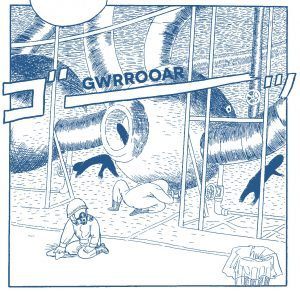 In October 2011, seven months after the tsunami and meltdowns, a second collection of the artist’s work was published in Japan, again to much acclaim. Titled Deep Sea Fish (Shinkaigyō), the volume reprinted stories that Katsumata drew in the 1980s about the disposable laborers who clean and maintain Japan’s nuclear power plants, as well as others he wrote in the 1970s dealing (sometimes indirectly) with the way industrialization had upended the Japanese countryside, creating a new class of alienated immigrants in the cities and a world of vanishing fables in the interior. This juxtaposition reflects the trajectory of the artist’s own life. He was born and raised in a farming village named Kahoku-cho, located on the Kitakami River just north of the major port city of Ishinomaki in northern Japan. Here, he spent his non-school hours reading comics and tending the family cows. After graduating high school in 1962, Katsumata moved to Tokyo to take up a job selling high-end laboratory equipment for a subsidiary of Hitachi. In 1965, he entered Tokyo University of Education, got a degree in physics, and began a master’s in nuclear physics, but quit in 1971 to focus full-time on cartooning.
In October 2011, seven months after the tsunami and meltdowns, a second collection of the artist’s work was published in Japan, again to much acclaim. Titled Deep Sea Fish (Shinkaigyō), the volume reprinted stories that Katsumata drew in the 1980s about the disposable laborers who clean and maintain Japan’s nuclear power plants, as well as others he wrote in the 1970s dealing (sometimes indirectly) with the way industrialization had upended the Japanese countryside, creating a new class of alienated immigrants in the cities and a world of vanishing fables in the interior. This juxtaposition reflects the trajectory of the artist’s own life. He was born and raised in a farming village named Kahoku-cho, located on the Kitakami River just north of the major port city of Ishinomaki in northern Japan. Here, he spent his non-school hours reading comics and tending the family cows. After graduating high school in 1962, Katsumata moved to Tokyo to take up a job selling high-end laboratory equipment for a subsidiary of Hitachi. In 1965, he entered Tokyo University of Education, got a degree in physics, and began a master’s in nuclear physics, but quit in 1971 to focus full-time on cartooning.
more here.
The Unlearned Lessons of the 2008 Meltdown
Chris Lehmann at The Baffler:
 IT’S BEEN TEN YEARS NOW since the American economy nearly pitched itself carelessly into the abyss, taking a great deal of the rent-collecting structure of neoliberal capitalism along with it. As our thought-leading elite begins taking stock of the Great Recession’s tangled legacy, we do well to pause amid the great tax-slashing, trade-battering, wage-stagnant Guignol of our Trumpified political economy, and marvel at just how epically oafish our leadership class is when it comes to the simple processing of elementary information and market trends.
IT’S BEEN TEN YEARS NOW since the American economy nearly pitched itself carelessly into the abyss, taking a great deal of the rent-collecting structure of neoliberal capitalism along with it. As our thought-leading elite begins taking stock of the Great Recession’s tangled legacy, we do well to pause amid the great tax-slashing, trade-battering, wage-stagnant Guignol of our Trumpified political economy, and marvel at just how epically oafish our leadership class is when it comes to the simple processing of elementary information and market trends.
There is, to begin with, the whole sad mobbed-up social mythology of austerity as the panacea of first resort in all imaginable circumstances. In the latter half of 2008, as Wall Street became a wind tunnel of toxic, overleveraged debt, all our most sober founts of economic wisdom concurred that we couldn’t embark on the Keynesian program of pump-priming that the shell-shocked American economic order desperately needed; no, this crisis was a moment for inflation hawks and assorted other ghouls to close ranks and issue stern rebukes of the economic mayhem wreaked by financial stimulus.
more here.
